A lot of people ask me about the keyword optimization tool… Let me clear those doubts. Keyword optimization tool is nothing but a keyword research tool.
In this article, I will guide you in everything from what is keyword research? How to pick the right keyword? I have also shared some techniques, make sure to read the full article…
This technique will help your blog post to rank at the top of the Google SERP…
So, let’s start…
Table of Contents
What is keyword optimization (keyword research)?
Keywords are the words and phrases that people type in search engines to find what they are looking for.
Keyword optimization (also known as keyword research) is the act of researching, analyzing, and selecting the best keywords in order to target the best traffic…
For example, if you want to buy a new jacket, you can type something like “mens leather wallet” into Google. Although that phrase consists of more than one word, it is still a keyword.

So when people search for that keyword or phrase on Google or other search engines, they should find that page on your website.
Benefits of Keyword Optimization
In a recent survey, participants listed keyword optimization as one of the most difficult tasks in search engine marketing.
Due to its difficult nature, most site owners, marketers, and bloggers don’t spend enough time optimizing keywords.
This is ironic, as optimizing for keywords is the most important aspect of SEO and PPC. If you don’t choose and use the keywords, your customers are looking for, you won’t get found. That means no traffic, no sales, no money.
So to see the big picture, you need to practice search engine keyword optimization to:
- To drive the qualified traffic to your website, you must optimize for the keywords they’re searching for
- Analyzing the popularity of keywords helps you to measure the size of a potential online market.
- By incorporating optimized keywords into your website content, you can instantly connect with potential customers.
- By analyzing the words your customers use, you get an idea of their needs and how to serve those needs.
Keyword Optimization Checklist
Once you know the primary keyword and secondary keywords for your page, create your content and optimize your post.
Use this checklist to make sure you are using the proper keyword optimization techniques across the page.
- The primary keyword must be in the page title.
- Near the beginning of the page title, the primary keyword should be included.
- At least one subheading, the primary keyword should be included.
- The first paragraph of the body copy should include the primary keyword.
- Content should be between 300 and 10,000 words.
- Keyword density is about 2-3% depending on the length of the content.
- Each secondary keyword is used at least one time.
- The content uses semantic search phrases that reinforce your topic and primary keyword.
- The permalink should also include the primary keyword.
- Url structure or the permalink must be under 128 characters.
- The meta title should also include the primary keyword.
- The primary keyword is near the beginning of the meta title.
- The meta title is unique and not a duplicate of other meta titles on your site.
- The meta title is 66 characters or less.
- The primary keyword is near the beginning of the meta description.
- The meta description is 320 characters or less.
- A least one image is on the page.
- The primary keyword is in an image alt tag on the page.
- The primary keyword is in an image file name used on the page.
- internal links to the page from pages on your site that are relevant to your topic and primary keyword.
- Internal links lead from the page to other pages on your site using the linked page’s target keyword.
- Outbound links lead to related content on high-quality sites.
- Use this checklist to make sure you cover all your keyword optimization bases.
For doing keyword research, a software tool is used called keyword research tool or keyword optimization tool.
You can use the KWFinder keyword research tool to get the best keyword research …
This tool displays all the keywords related to that niche with all the keyword matrices like keyword difficulty, search volume, etc. Using this tool, you can find keywords that are low in competition.
Keyword Research Using a Fresh & Massive Database
Our keyword research tool offers relevant keyword recommendations from multiple sources: our own up-to-date database and massive databases such as Google Keyword Suggestions and Google AutoComplete, as well as other keyword database sources.
The KW Finder Keyword Tool will help you discover thousands of profitable, specific keywords and topics, including the exact keywords that people are typing into the Google search box.
Even if you are looking for short, medium, or long tail keywords, our keyword research tool will give you the best tips and insights for the best content creation.
Proper Keywords On Your Content Is Missing to Rank Higher
If you want your content marketing strategy to pay off, you will need to properly optimize your content around the right keywords.
Our keyword research tool will tell you the exact keywords and phrases you need to use to secure your spot at the top.
You will know what are the keywords that improve the ranking of your competitors and discover the content strategies of any website immediately.
Free vs. paid keyword tools: how do they compare?
It’s simple – free keyword tools are limited compared to paid tools.
That’s not to say that free tools don’t have their use. But the number of keyword ideas and data they give access to will always pale in comparison to paid tools.
Because of this, paid tools allow you to go much deeper and conduct more advanced market research.
To illustrate, here’s what happens if we type “protein powder” into KW Finder, with over 123,000 “phrase match” suggestions from our database.
No free keyword tool runs on such a large database.
We also show tons of data points, including:
- Estimated monthly search volume;
- Keyword Difficulty (KD);
- Clicks;
- CPC
- And everything is searchable, filterable, and returned in seconds.
- We add new keywords to our database and refresh search volumes every month.
Doing this with free keyword tools would be next to impossible.
Also, to make real decisions about a keyword’s competitiveness, you need to analyze the top 10 ranking pages.
Keyword Types
Keywords are important because your website can show up when people enter them in search engines.
Keywords are of two types
- Short tail keyword (aka Generic Keyword)
- Long tail keyword
1. Short tail keyword:
Short tail keywords are search phrases with just one or more words. Their length makes them less specific than searches with more words.
- This keyword contains 1 to 2 words
- It has a high search volume.
- Has high competition
- Difficult to rank with these keywords
- Better known as a broad keyword
- An example of this keyword is “egg”
2. Long tail keywords:
Long tail keywords are those three or four keyword phrases that are very specific to what you are selling.
Long-tail keywords get less search traffic, but will generally have a higher conversion value as they are more specific.
- This keyword contains 3 to 6 words.
- Has a low search volume
- Has little competition
- It’s easy to rank on Google using these keywords.
- An example of this keyword is “ppc branding tactics”
Long Tail Keywords has more benefits, here is the reason
- Long tail keywords are much easier to rank for than short-tail keywords due to the relatively low competition.
- These types of keywords have better conversion rates because the people who use them know more about what they want.
- It can help optimize your website for different search engine categories because they are more specific.
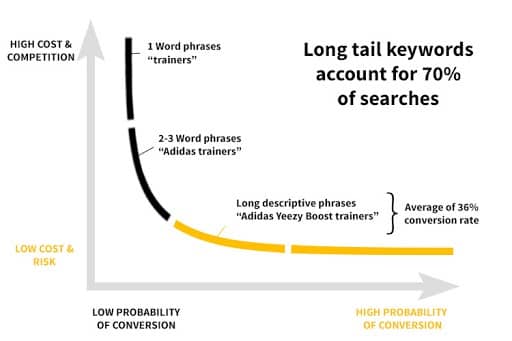
Voice search makes long-tail keywords more important than ever
The shift to long-tail keywords will be even more essential for SEO success in 2021. Why? Due to voice search.
According to Google’s Behshad Behzadi, 55 percent of teens and 40 percent of adults use Google’s mobile app voice search tool every day.
Virtual assistants like Siri, Alexa, and Google Voice Search started dominating the consumer space in 2017. Almost everyone has one of these programs or some kind of voice search feature available, on their phone, at home, or even on their desktop PC.
Mobile device users, in particular, have leaned toward voice search rather than wasting time with swipe controls or performing a search query.
It’s a large audience that can potentially be lost if you’re not tweaking your keyword strategy to meet their search terms.
Voice search queries and traditional search terms are inevitably going to diverge from one another. When someone speaks in a voice search app, they will almost certainly use a more conversational tone.
Whereas if they wrote “keyword optimization best practices” in the Google search bar, they are more likely to say “Google, what are the best keyword optimization techniques I should use?“ when using the voice search tool.
As such, long-tail keywords that reflect that conversational tone will become more useful and better match the user’s intent with the right piece of content.
It is also very important to know the search intent while doing keyword research. Knowing the search intent for that specific keyword will give you an idea to write the content. It will also help to boost your rankings.
Did you know you can rank your blog in Google SERP in just 48 hours?
Yes, you heard it right…
It is possible to rank a blog post in Google SERP’s Top-50 in just 48 hours by using a technique called KGR (Keyword Golden Ratio).
It’s a data-driven method called the Keyword Golden Ratio that will help you find the keywords that are actually low in competition and there is a huge demand for that content targeting that specific keyword.
In this mini-guide, you’ll find:
- What is Keyword Golden Ratio and how does it work?
- How to use a keyword tool to make the process easier?
- And some actual examples of KGR terms
(If you prefer video content, you can check out my demo of the KGR with KWFinder)
What is Keyword Golden Ratio?
Keyword Golden Ratio (KGR) is a data-driven way to find keywords that are literally underserved on the internet.
If you find a keyword golden ratio phrase and publish a piece of content targeting that keyword, your article should rank in the top 50 in a few days, sometimes hours.
If your site has a decent authority and isn’t brand new, then you can rank in the top 15.
The KGR is helpful for three main reasons:
- The KGR helps newbies make small profits faster. It is amazing to get your first visitors and sales.
- If you are looking at a list of thousands of keywords, it helps to have a tool that can help you narrow down the list.
- Since it is a manual process, you have data that other people cannot get into a tool in a couple of minutes.
How is Keyword Golden Ratio calculated?
The number of Google results that have the keyword phrase in the title divided by the monthly search volume, where the search volume is less than 250.
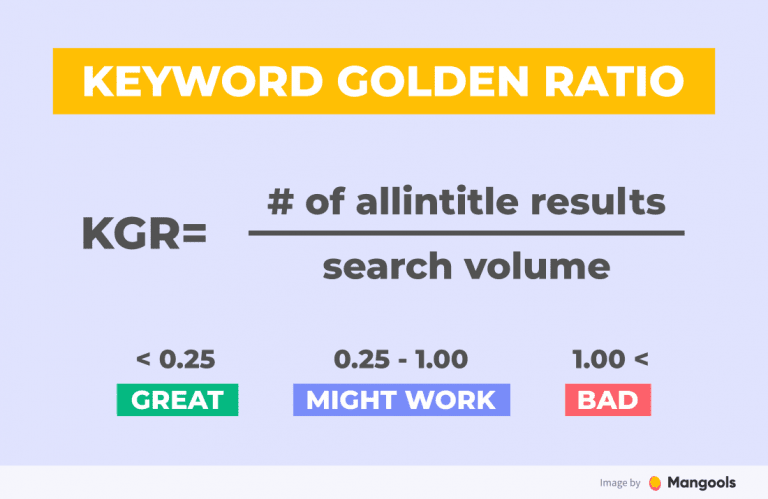
If the KGR is less than 0.25, then you should rank in the top 50 as soon as your page is indexed.
If the KGR is between 0.25 and 1 you should rank in the top 250 and it should be pretty fast.
What is allintitle?
Allintitle is an advanced Google search operator that outputs the results which have all the words in the meta title of the post.
The Allintitle search operator shows you the results that have all the searched words in the meta title.

It basically means, the phrase you searched in the search box of Google, has to be included in the title of the post.
How to use a keyword tool (Keyword Optimization Tool) to find KGR terms?
Now I’ll show you a few real examples of keywords that fit the KGR.
We’ll use an example of a niche that has been used in several public case studies – the shaver niche.
1. Find relevant keyword ideas
One of my favorite ways to find KGR-compliant terms is to use Google Autosuggest.
You can do this manually and it looks like this:
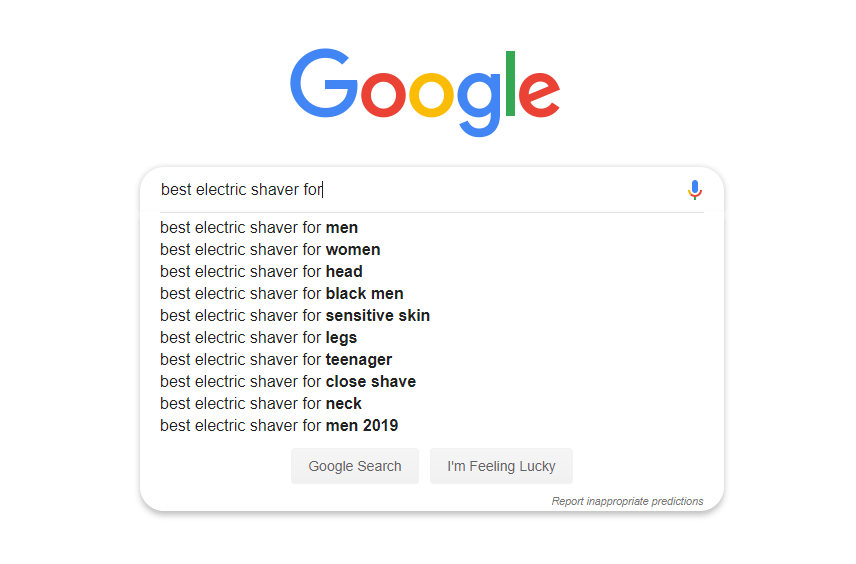
But you can save a lot of time and effort by using a keyword tool such as KWFinder with advanced filtering options and the Keyword Difficulty (KD) metric.
First, select Autocomplete and enter your search phrase, then click on the “Find Keywords” button:

Then you’ll see the unfiltered list of results. We care about the Search Volume and Keyword Difficulty – the other metrics aren’t important now.
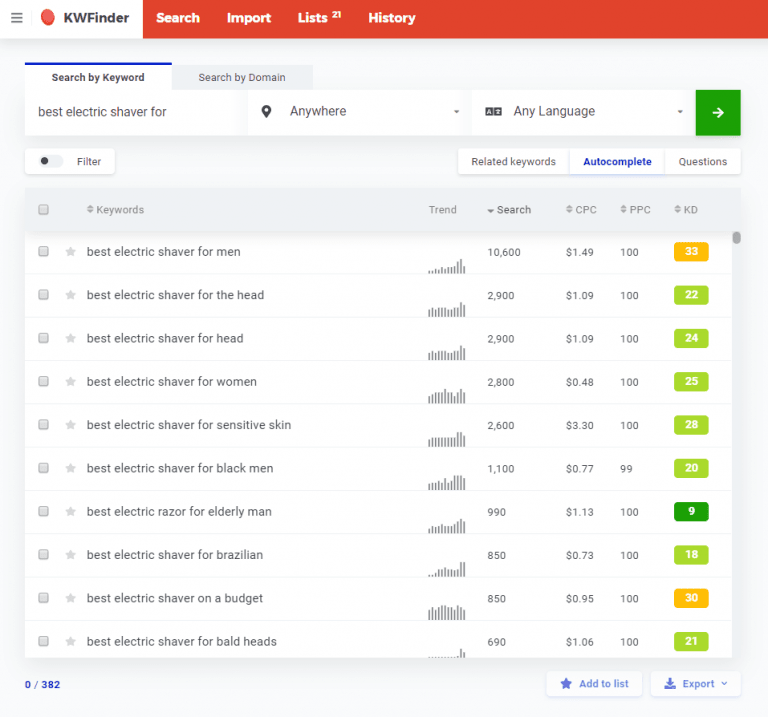
For this example, I left the geography as “Anywhere,” but you can select your target location.
2. Filter out keywords with search volume higher than 250
Remember the KGR requires that the search volume is under 250. That means we can set up the filter to get rid of the keywords that we don’t care about.
Enter in 250 for the MAX search volume in the filter.
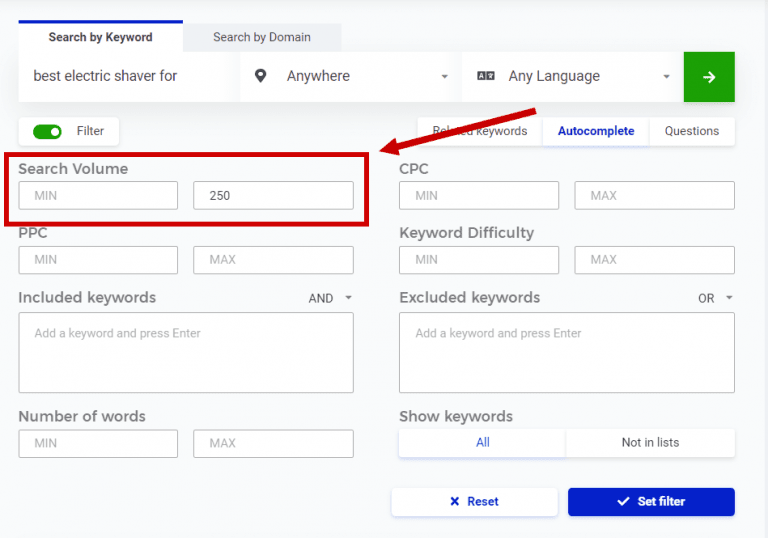
Click the blue “Set filter” button and the list is refined by removing the higher search volumes.
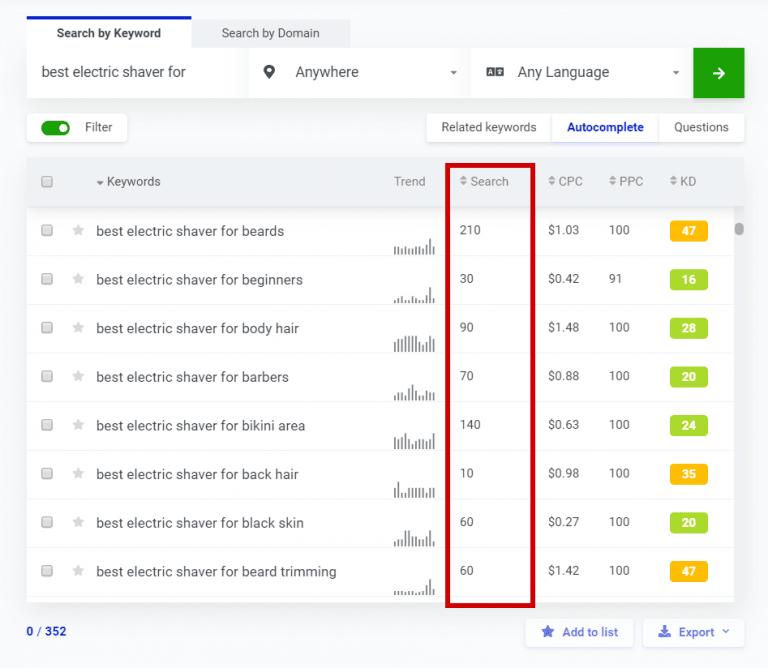
Now, we have plenty of options that have a search volume under 250. You could add more criteria to the filter such as a KD max of 15, 20, 25, etc…
I see the results for this Autosuggest search that “best electric shaver for ingrown hairs” has a favorable KD value at 17.
The search volume is 150, which fulfills the requirement to be less than 250.
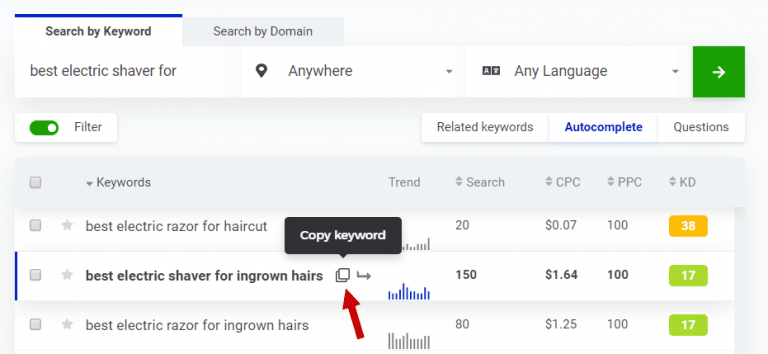
You can hover over the row and click to copy the full keyword phrase to save time.
3. Find the number of websites with exact match titles
Next, you need to check the allintitle, the advanced Google Search command.
You type in allintitle: and the search phrase with no spaces and no quotes. Don’t enter the quotes because that will lower the number of results which will throw off your calculations.
Google returns the number of results which is the numerator in the KGR formula.

We see there are 22 results so we can plug that into the formula.
KGR = (allintitle results) divided by (search volume)
KGR = 22 / 90 = 0.14
Great! That’s less than 0.14 so we have a KGR compliant term.
KWFinder also has great metrics for each keyword so you can do competition analysis without leaving the app. That’s a massive time saver!

Wrap up
Don’t get me wrong; You can find some good keywords with free keyword tools. But doing so can take a long time. And time is money.
The reality is that the time spent pulling Google autocomplete for queries is a waste of time. The same goes for combining data from several free keyword tools in spreadsheets.
You should aim to use that time for more important things, like creating content and building links. Also, paid keyword tools like KW Finder run on huge amounts of data.
I still recommend you to go for KWFinder as this tool is dedicated to finding ultra long-tail keywords and also provides much information about the keyword like Keyword Difficulty, Search Volume, etc.
It can change the way you look at long-tail keywords so that you can be confident that your content will get the attention it deserves.
It’s the best and most affordable keyword optimization tool available on the internet.
FAQ
Free keyword tools are limited compared to paid tools. That’s not to say that free tools don’t have their uses. But they provide only a limited number of keyword ideas and also, they don’t provide other keyword matrices which is important for keyword optimization
Keywords are the words and phrases that people type in search engines to find what they are looking for. For doing keyword research, a software tool is used called keyword research tool or keyword optimization tool…
Keyword optimization (also known as keyword research) is the act of researching, analyzing, and selecting the best keywords to target qualified traffic from search engines to your website.
Keyword Golden Ratio (KGR) is a data-driven way to find keywords that are literally unused on Google. If you find a keyword golden ratio phrase and you publish a piece of content targeting the keyword, your article should rank in the top 50 within a few days
More information about Keyword Research can be found on this page.
You can use this guide for keyword research and to improve your website’s search engine ranking.
